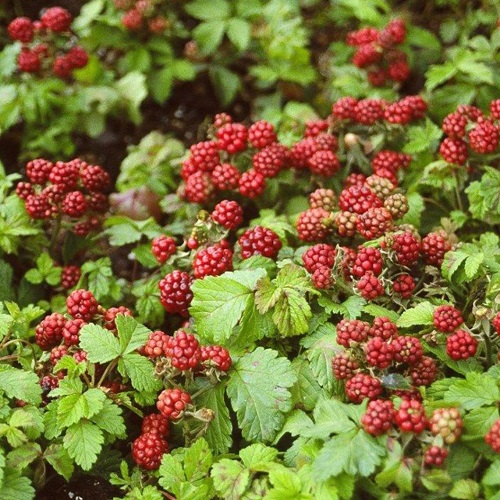Arctic Raspberry : ANNA 2 ½" pot
$6.95
(Rubus arcticus L subsp. x stellarcticus)
These super-hardy Swedish selections are possibly the most uncommon members of the whole Raspberry clan. The low growing, thornless plants spread by root rhizomes, forming a thick mat of bright green trifoliate leaves, no more than 15cm (6") tall. By late spring the carpet is adorned with small, pinkish blossoms followed by dainty, delicious and aromatic red raspberries in mid summer. The fall foliage is a feast for the eyes with shades of crimson and burgundy. In early spring the plants bounce back from the roots.
We offer several of Dr. Gunny Larssen's favourites, selected on the basis of plant vigour as well as fruit quality, quantity and flavour. Although practically identical, two varieties are needed for pollination.
Plant 30-60cm (1-2') apart in a well-drained, sunny spot.
PLANT WITH VALENTINA | ZONE 2 | HARVEST: LATE JULY-AUG.
Growing Tips
Tipping or tip pruning is highly recommended for black and purple raspberry canes. As the primocanes (first year canes) reach 90-120 cm (3-4'), pinch or cut 8-15 cm (3-6”) off the tips to force branches to develop. Tipping will delay, but prolong, the harvest, increase yield and reduce arching of the canes and tip rooting. Pruning later in the season decreases the amount of time the plant will have to develop the branches. Not pruning the primocanes will allow earlier ripening than the tip-pruning option, however the
canes will become tall and arching, and will develop fewer berries.
Raspberry canes MUST be kept moist until they are in the ground. In fact, we believe that the main reason that canes fail to grow is from the root hairs becoming dry at some point in the planting process.
We suggest using Soil Moist root dip (see page 81). Soak the roots for 1-2 hours just before planting. From our own experience it is highly effective. It is also recommended for other plants – blackberries, strawberries, etc.

